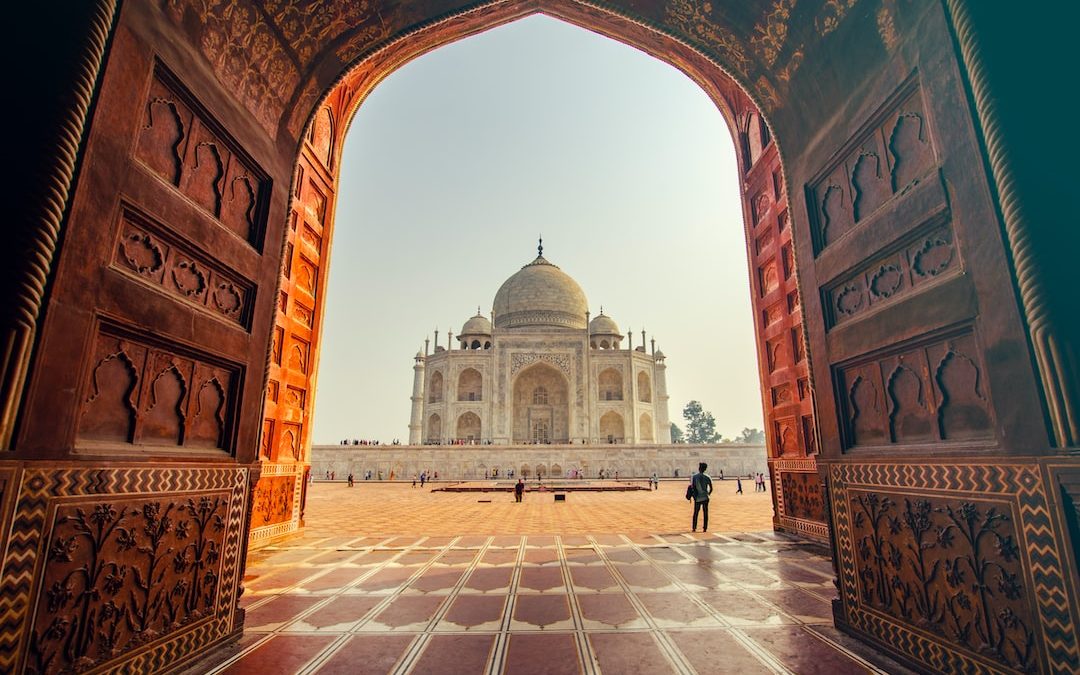Table of Contents
Experience the Majesty of the Taj Mahal
The Taj Mahal is a stunningly beautiful monument that stands tall in Agra, India. It is one of the most iconic symbols of India and is a UNESCO World Heritage Site. Built in the 17th century by Mughal Emperor Shah Jahan as a tribute to his beloved wife, Mumtaz Mahal, it has since been seen as a symbol of love and devotion. The Taj Mahal is one of the most famous tourist attractions in the world and is a must-visit if you’re ever in India.
The Architectural Grandeur of the Taj Mahal
The Taj Mahal is an awe-inspiring architectural masterpiece that features a blend of Persian, Central Asian, and Indian architectural styles. The monument is made of white marble and is surrounded by lush gardens, manicured lawns, and fountains. The monument consists of four minarets, each with a height of 40 meters, and a central dome that is about 75 meters high. Inside the main chamber lies a tomb of Mumtaz Mahal, the wife of Shah Jahan for whom the Taj Mahal was built.
The intricate carvings and designs that adorn the exterior of the Taj Mahal are simply breathtaking. The walls of the monument are adorned with intricate floral patterns and inscriptions from the Quran. The interior is equally impressive, featuring intricate marble inlay work and colorful paintings.
The Taj Mahal is surrounded by lush gardens and manicured lawns, which add to the beauty of the monument. The gardens are filled with fruit trees, flowers, and fountains, which make it an ideal place to relax and take in the grandeur of the monument.
The Legacy of the Taj Mahal
The Taj Mahal is a symbol of love and devotion that has stood the test of time. It is seen as a symbol of India’s rich cultural heritage and is admired by many for its beauty and grandeur. The monument is also seen as a symbol of Islamic architecture and has been a source of inspiration for many architects around the world.
The Taj Mahal is also a symbol of India’s resilience and strength. It has survived numerous natural disasters and political upheavals over the centuries and still stands today as a testament to India’s strength and perseverance.
The Taj Mahal is also a symbol of India’s rich cultural heritage. It is a reminder of the country’s long and illustrious history and a symbol of the country’s commitment to preserving its cultural heritage.
The Science Behind the Taj Mahal
The Taj Mahal is an architectural marvel, but it is also a scientific marvel. The monument was built using advanced engineering techniques, such as the use of complex geometrical shapes and mathematical equations, to ensure its stability. The monument was also built using advanced construction materials, such as marble, sandstone, and granite, to ensure its longevity and durability.
The Taj Mahal also features an ingenious water system that was designed to keep the monument cool during the hot summer months. The system was designed to collect and store rainwater, which was then used to irrigate the gardens around the monument.
The Taj Mahal also features an intricate air-cooling system that was designed to keep the interior of the monument cool. The system was designed to keep the temperature of the monument at a comfortable level, even during the hottest days of the year.
The Significance of the Taj Mahal
The Taj Mahal is a symbol of India’s rich cultural heritage and a reminder of the country’s commitment to preserving its cultural heritage. It is also seen as a symbol of love and devotion, and a testament to the strength of the human spirit.
The Taj Mahal is also a symbol of India’s resilience and strength. It has survived numerous natural disasters and political upheavals over the centuries and still stands today as a testament to India’s strength and perseverance.
The Taj Mahal is a source of pride for India and its people, and it continues to be an inspiration to millions of people around the world.
The Cultural Significance of the Taj Mahal
The Taj Mahal is a symbol of India’s rich cultural heritage and is admired by many for its beauty and grandeur. The monument is also seen as a symbol of Islamic architecture and has been a source of inspiration for many architects around the world.
The Taj Mahal is also a reminder of the importance of preserving cultural heritage. The monument is a reminder that it is important to preserve the cultural heritage of a nation and to ensure that it is not lost to future generations.
The Taj Mahal is also a reminder of the power of love and devotion. The monument was built as a tribute to the love of Shah Jahan for his beloved wife Mumtaz Mahal, and is a testament to the strength of the human spirit.
The Spiritual Significance of the Taj Mahal
The Taj Mahal is a symbol of spiritual devotion and is seen as a sacred place of worship by many. The monument is believed to be a place of spiritual energy and many people visit the site in order to seek peace and solace.
The Taj Mahal is also a symbol of the divine power of love. It is believed that the monument was built in order to honor the divine power of love, and it is seen as a reminder of the power of love to transcend all boundaries.
The Taj Mahal is also a reminder of the importance of respecting nature. The monument is surrounded by lush gardens and manicured lawns, which add to the beauty of the monument and serve as a reminder of the importance of preserving nature.
The History of the Taj Mahal
The Taj Mahal was built in the 17th century by Mughal Emperor Shah Jahan as a tribute to his beloved wife, Mumtaz Mahal. The monument was built over a period of 22 years and is an architectural marvel, featuring a blend of Persian, Central Asian, and Indian architectural styles.
The Taj Mahal has stood the test of time and has survived numerous natural disasters and political upheavals over the centuries. It is a symbol of India’s rich cultural heritage and a reminder of the importance of preserving cultural heritage.
The Taj Mahal is also a symbol of love and devotion, and a testament to the strength of the human spirit. It is a source of pride for India and its people, and it continues to be an inspiration to millions of people around the world.
The Best Time to Visit the Taj Mahal
The best time to visit the Taj Mahal is between the months of October and March, when the weather is cooler and the days are longer. The monument is open to visitors from sunrise to sunset, and the entrance fee is equivalent to about $12. It is also possible to visit the monument at night, when it is illuminated by floodlights.
Visitors are advised to dress modestly when visiting the Taj Mahal, as it is a place of worship, and all visitors must remove their shoes before entering the monument. Visitors are also advised to bring a hat and sunblock, as the monument can get very hot during the summer months.
The Taj Mahal is a must-see for anyone visiting India and is a reminder of the country’s rich cultural heritage and a symbol of the power of love and devotion.
Conclusion
The Taj Mahal is one of the most iconic monuments in the world and is a must-visit for anyone traveling to India. The monument is a symbol of India’s rich cultural heritage and a reminder of the importance of preserving cultural heritage. It is also a symbol of love and devotion and a testament to the strength of the human spirit. The Taj Mahal is a source of pride for India and its people, and it continues to be an inspiration to millions of people around the world.












